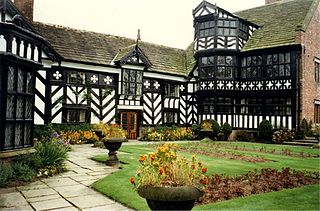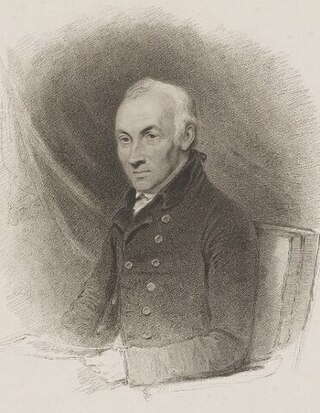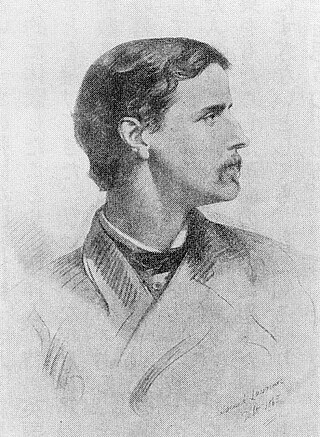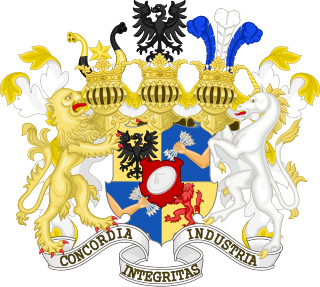
Chatsworth House is a stately home in the Derbyshire Dales, 4 miles (6.4 km) north-east of Bakewell and 9 miles (14 km) west of Chesterfield, England. The seat of the Duke of Devonshire, it has belonged to the Cavendish family since 1549. It stands on the east bank of the River Derwent, across from hills between the Derwent and Wye valleys, amid parkland backed by wooded hills that rise to heather moorland. The house holds major collections of paintings, furniture, Old Master drawings, neoclassical sculptures and books. Chosen several times as Britain's favourite country house, it is a Grade I listed property from the 17th century, altered in the 18th and 19th centuries. In 2011–2012 it underwent a £14-million restoration. The owner is the Chatsworth House Trust, an independent charitable foundation formed in 1981, on behalf of the Cavendish family.

Gawsworth Old Hall is a Grade I listed country house in the village of Gawsworth, Cheshire, England. It is a timber-framed house in the Cheshire black-and-white style. The present house was built between 1480 and 1600, replacing an earlier Norman house. It was probably built as a courtyard house enclosing a quadrangle, but much of it has been demolished, leaving the house with a U-shaped plan.

Marlborough House, a Grade I listed mansion on The Mall in St James's, City of Westminster, London, is the headquarters of the Commonwealth of Nations and the seat of the Commonwealth Secretariat. It is adjacent to St James's Palace.

William Mitford was an English historian, landowner, and politician. His best known work is The History of Greece, published in ten volumes between 1784 and 1810.

In the 19th century members of the English Rothschild family bought and built many country houses in the home counties, furnishing them with the art the family collected. The area of the Vale of Aylesbury, where many of the houses were situated, became known as "Rothchildshire". In the 20th century many of these properties were sold off with their art collections dispersed. Today only Eythrope House still belongs to the family; however, they still retain influence in how Ascott House and Waddesdon Manor are managed. In the loss of country houses in the 20th century only Aston Clinton was lost.

Ascott House, sometimes referred to as simply Ascott, is a Grade II* listed building in the hamlet of Ascott near Wing in Buckinghamshire, England. It is set in a 32-acre / 13 hectare estate.

Halton House is a country house in the Chiltern Hills above the village of Halton in Buckinghamshire, England. It was built for Alfred Freiherr de Rothschild between 1880 and 1883. It is used as the main officers' mess for RAF Halton and is listed Grade II* on the National Heritage List for England.

Algernon Bertram Freeman-Mitford, 1st Baron Redesdale, was a British diplomat, collector, and writer who wrote as A.B. Mitford. His most notable work is Tales of Old Japan (1871). Nicknamed "Berty", he was the paternal grandfather of the Mitford sisters.

Exbury is a village in Hampshire, England. It is in the civil parish of Exbury and Lepe. It lies just in the New Forest, near the Beaulieu River and about a mile from the Solent coast. It is best known as the location of Exbury House, built by the Rothschild family, and the famous Exbury Gardens. The Rothschild family still have significant land ownings in the area.

Exbury Gardens is a 200-acre (81 ha) informal woodland garden in Hampshire, England with large collections of rhododendrons, azaleas and camellias, and is often considered the finest garden of its type in the United Kingdom. Exbury holds the national collection of Nyssa (Tupelo) and Oxydendrum under the National Plant Collection scheme run by the Plant Heritage charity. The gardens are rated Grade II* on the National Register of Historic Parks and Gardens.

Major Lionel Nathan de Rothschild, OBE was a British banker and Conservative politician best remembered as the creator of Exbury Gardens by the New Forest in Hampshire. He was the eldest son of Leopold de Rothschild (1845–1917) and a part of the prominent Rothschild banking family of England. In 1910, he was elected to the House of Commons. In 1917, he co-founded the anti-Zionist League of British Jews.

Gunnersbury Park is a park between Acton, Brentford, Chiswick and Ealing, West London, England. Purchased for the nation from the Rothschild family, it was opened to the public by Neville Chamberlain, then Minister of Health, on 21 May 1926. The park is currently jointly managed by Hounslow and Ealing borough councils. A major restoration project funded by the Heritage Lottery Fund was completed in 2018. The park and garden is Grade II listed.

Tring Park Mansion or Mansion House, Tring Park, is a large country house in Tring, Hertfordshire. The house, as "Tring Park", was used, and from 1872 owned, by members of the Rothschild family from 1838 to 1945.

The Rothschild banking family of England is the English branch of the Rothschild family. It was founded in 1798 by Nathan Mayer Rothschild (1777–1836), who first settled in Manchester before moving to London, England, which was then part of the Kingdom of Great Britain. He was sent there from his home in Frankfurt by his father, Mayer Amschel Rothschild (1744–1812). Wanting his sons to succeed on their own and to expand the family business across Europe, Mayer Amschel Rothschild had his eldest son remain in Frankfurt, while his four other sons were sent to different European cities to establish a financial institution to invest in business and provide banking services. Nathan Mayer Rothschild, the third son, first established a textile jobbing business in Manchester and from there went on to establish N M Rothschild & Sons bank in London.
Anthony Gustav de Rothschild was a British banker and member of the Rothschild family.
Charlotte Henriette de Rothschild is a British soprano, specialising in the recital and oratorio repertoire, who is a member of the Rothschild banking family of England.

Baron Guy Édouard Alphonse Paul de Rothschild was a French banker and member of the Rothschild banking family of France. Between 1967 and 1979, he was the chairman of the French Banque Rothschild, nationalized by the French government in 1982, and maintained investments in other French and foreign companies, including Imerys. He was named to the International Best Dressed List Hall of Fame in 1985.

Great Wolford is a village and civil parish in the Stratford-on-Avon district of Warwickshire, England. With the neighbouring parish of Little Wolford it is part of 'The Wolfords'.
The Rothschild family is a European family of German Jewish origin that established European banking and finance houses from the late eighteenth century.
Ambrose Christian Congreve CBE was an Irish industrialist, best known for his world-famous garden at Mount Congreve.

















